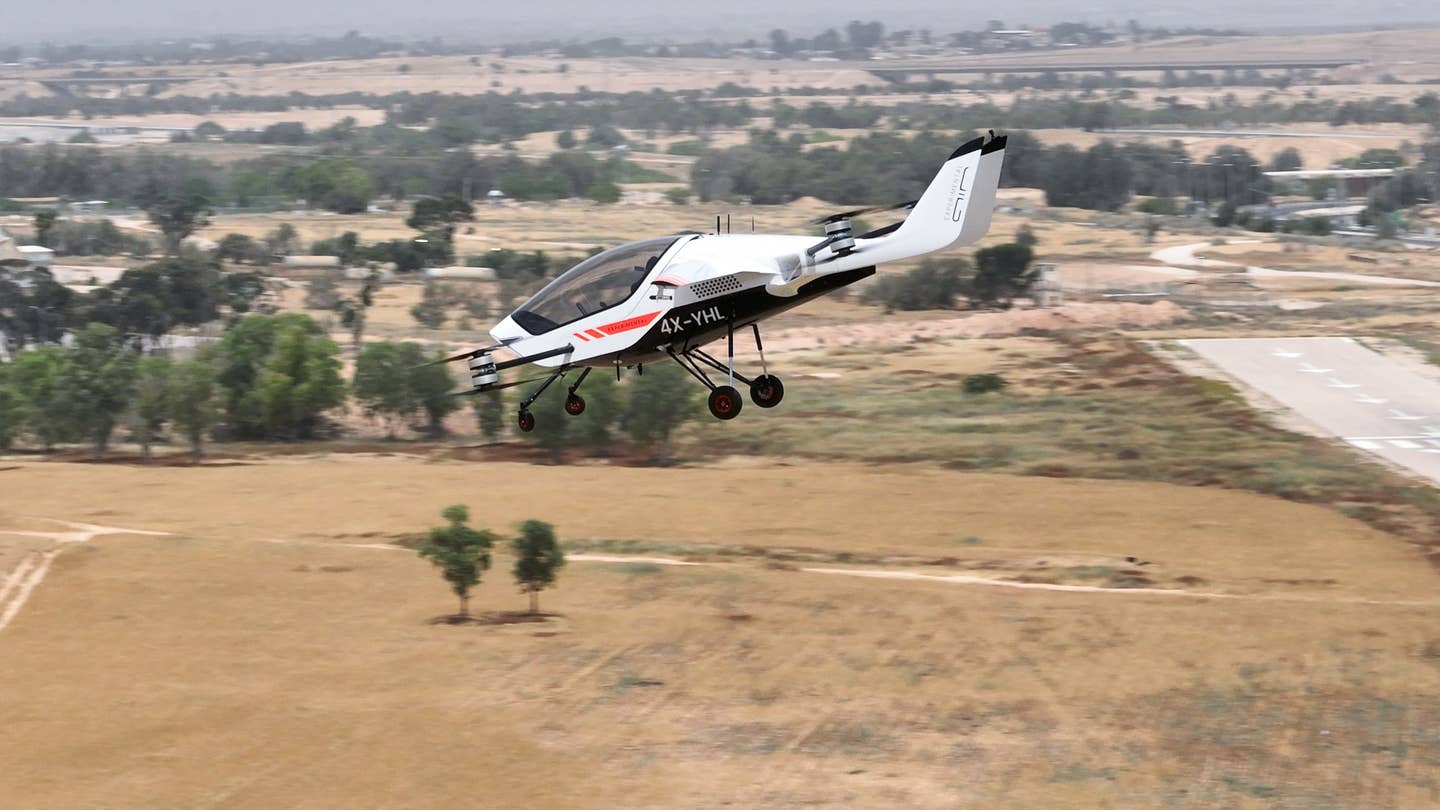Private eVTOL Startup Air Signs UAS Traffic Management Deal
Israel-based company represents one of a handful of firms that are producing eVTOLs for personal use.

Air’s Air One prototype makes its first transition to cruise flight. [Courtesy: Air]
If firms like Joby Aviation and Archer Aviation are to be believed, the U.S. will have electric vertical takeoff and landing (eVTOL) air taxis buzzing in its airspace by 2025. But there’s another kind of eVTOL aircraft under development.
Israel-based startup Air is one of a handful of firms manufacturing the helicopter-like vehicles for private use. The company has been quiet for a few months. But on Monday, it announced a partnership with another Israeli firm, High Lander, to provide unmanned aircraft systems (UAS) traffic management (UTM) services for its two-seater Air One personal eVTOL.
As the air taxi industry works to establish standards for certification and safe flight, personal eVTOL aircraft like the Air One will likely encounter the same challenges—only amplified.
“We expect Air One to become the flagship of a new age of personal transportation, and therefore we consider safety and compliance to be of the utmost importance,” said Rani Plaut, CEO and co-founder of Air. “By taking advantage of the scalable and comprehensive air traffic coverage of High Lander’s tried-and-tested UTM system, we feel confident that Air One will overcome its last regulatory hurdles and begin to show people around the world that piloting a personal aerial vehicle is as safe and reliable as it is easy and exciting.”
First revealed in 2021, Air’s flagship design is smaller and less powerful than a typical air taxi, with a 550-pound payload, 100-mile range, and one-hour flight time. But unlike Joby or Archer’s aircraft, Air One will likely fly outside of dedicated air taxi routes, such as the one Archer and United are planning in Chicago. In fact, per Air's website, the company envisions Air One being stored and launched directly from users’ homes.
That presents a unique predicament. Departing FAA head Billy Nolen has said early eVTOL operations will rely on existing air traffic management infrastructure and dedicated advanced air mobility (AAM) corridors. The FAA’s blueprint supports the vision of Archer, Joby, and other manufacturers who plan to start flying to and from the airport. But it leaves out firms like Air, which envisions freewheeling flights that take off and land from places like driveways and backyards.
That’s where High Lander comes in. Air will use the company’s Universal UTM system to autonomously provide flight plan approvals and modifications, real-time flight monitoring, and in-flight conflict warnings, helping pilots abide by aviation regulations. According to Air, the companies in May successfully flew an Air One integrated with High Lander’s UTM through the Israel National Drone Initiative.
“Air One is an impressive feat of engineering and stands to have a dramatic effect on the way people travel. This brings with it regulatory and safety challenges that must be overcome before this new market can take off,” said Alon Abelson, CEO and co-founder of High Lander. “All of these challenges can be overcome with Universal UTM, and we’re proud to be providing the safety network for this groundbreaking product and a whole new generation of pilots.”
Air has accepted more than 300 preorder deposits for Air One at a price tag of $150,000, with plans to begin deliveries in late 2024. But the firm must first navigate the gauntlet of FAA approvals necessary to mass-produce the aircraft in the U.S., its first target market.
At present, it’s working toward a G-1 certification basis with the FAA: the same approval that set forth airworthiness standards required for type certification for Joby, Archer, and other eVTOL manufacturers.
The process is long and cumbersome. But Air received a lift when it completed prototype hover tests in June 2022, following that up in January with its first transition-to-cruise flight—the first of thousands of FAA-required flight hours. Shortly after, the company moved the bulk of its operations to the U.S., where it will conduct further flight testing and development.
More recently, Air partnered with the charitable yachting organization International SeaKeepers Society to support ship-to-shore transport, resupply missions, and shuttling of passengers and cargo.
“In addition to helping improve yacht logistics, this partnership enables yachters to add an extra layer of sky-high adventure to sea excursions and is a significant step in our mission to advance air mobility adoption around the world,” Plaut said of the collaboration.
What’s next for Air is anyone’s guess. So far, the company has been marketing Air One to non-pilots and GA pilots alike. But right now, there isn’t a single person on Earth who has been certified to fly an eVTOL, and for good reason—the technology is still in its infancy and likely several years away from safe, routine flights.
That could soon change as a new bipartisan bill calling for an AAM pilot certification process makes its way through Congress. Until it does, though, Air will need to find a way to certify its users and ensure they fly safely within crowded airspace. In short, Air will still have hurdles to clear after Air One certification.

Sign-up for newsletters & special offers!
Get the latest FLYING stories & special offers delivered directly to your inbox






